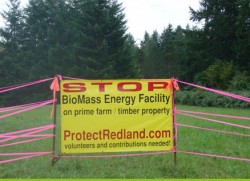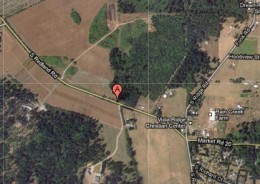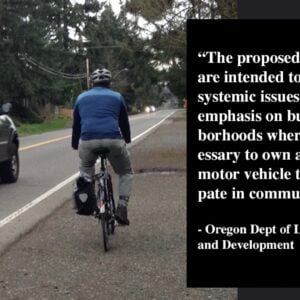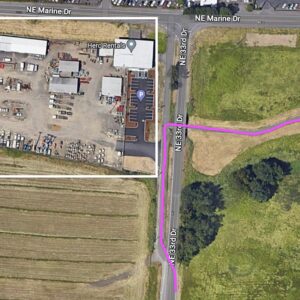
the project with signs like these.
(Photo: ProtectRedland.com)
A scenic road and popular bike route between Oregon City and the Clackamas River could be severely impacted if a proposed, 139 acre development moves forward. Clackamas Compost Products, LLC filed a permit in August with Clackamas County in hopes of building a yard debris composting and biomass energy facility on Redland Road (about 10 miles southeast of Oregon City, map here).
The proposed development has raised quite a bit of ire from surrounding residents, who fear the industrial facility will ruin the bucolic setting of surrounding farmland and pastures. A traffic study carried out by the company themselves says the facility will add an additional 100 heavy truck trips to the road.
“I understand the vehicle hazards Redland Road poses. The increase in heavy truck traffic is not acceptable. It is literally irresponsible.”
— Jerry Paul, local resident
People who care about high quality bike routes are also concerned about the development. On October 22nd, the Clackamas County Tourism & Cultural Affairs office wrote a letter to Planning Commission opposing the project. They say the facility will have an “adverse economic impact” on several nearby tourism attractions. One of the five attractions listed in their letter is the Clackamas River Bike Ride.
The Clackamas River Ride — five miles of which are on Redland Road — is an officially recognized recreational bike route that is included in Clackamas County’s bike tourism promotion efforts and is featured in their Bike It! Map. Redland Road is also classified as a “County Scenic Road,” a designation that Danielle Cowan, Executive Director of the
Clackamas County Tourism & Cultural Affairs department says is not compatible with the proposed facility.

In their land use application, Clackamas Compost Products says their trucks will carry large loads of eight or more tons. The amount of trips they’ll generate (up to 102 per day) on Redland Road, they say, is “a small portion” of the total daily trips and they’ll be made only during business hours. The company also says they’ll be sensitive to Redland’s “scenic road” designation by only having one access point, widening the shoulder, and by adding new landscaping and signage to the road.
Jerry Paul lives near the area and rides his bike all over the local country roads. “I understand the vehicle hazards Redland Road poses,” he wrote to us via email, “The increase in heavy truck traffic is not acceptable. It is literally irresponsible.” Jerry has joined a grassroots effort, ProtectRedland.com, to thwart the proposed facility.
The next public hearing for the project is on Monday, November 15th at 6:30pm at Oregon City High School (19761 S. Beavercreek Road). At that meeting, Clackamas Compost Products will make their final comments and rebuttals to the Planning Commission who will then forward a recommended decision to the Clackamas County Board of Commissioners. A final decision is expected to be made by December 1st





NIMBY!
“… a yard debris composting and biomass energy facility …” maus/bikeportland
139 acres is a large area of land to be devoting to this purpose. What the business will be composting and processing is more complicated than the description provided by Maus in his sentence above (no criticism intended).
The Save Redlands website provides a link to a DEQ Warning Letter/Opportunity to Correct, letter to Duane and Loretta Stroupe (I believe those folks are the business owners).
From that letter, here’s a description of some of the material that may be composted and processed on that property:
“… 1 Per OAR 340-093-0030(38) “Feedstock” means organic and other solid wastes used in a composting process to
produce composted material:
(a) Type 1 feedstocks include source-separated yard and garden wastes, wood wastes, agricultural crop residues,
wax-coated cardboard, vegetative food wastes including department approved industrially produced vegetative food
waste, and other materials the department determines pose a low level of risk from hazardous substances, physical
contaminants and human pathogens.
(b) Type 2 feedstocks include manure and bedding and other materials the department determines pose a low level
of risk from hazardous substances and physical contaminants and a higher level of risk from human pathogens
compared to type 1 feedstock.
(c) Type 3 feedstocks include dead animals, meat and source-separated mixed food waste and industrially produced
non-vegetative food waste. They also include other materials the department determines pose a low level of risk
from hazardous substances and a higher level of risk from physical contaminants and human pathogens compared to
type 1 and 2 feedstocks. …”
DEQ Warning Letter with Opportunity to Correct
Composting is a great idea, but on a scale this large, and so far removed from locations where the compostable material…(“feedstock”, as DEQ seems to term it) is produced,I’m not so sure.
i find this one kind of difficult to get behind. you have a company trying to implement a new renewable energy facility that would also create a few jobs in the area. i think the better use of the communities effort would be to keep pressure on Clackamas Compost Products, LLC to keep up their end of the deal about widening the shoulders and being aware of the needs of the community. I hope they can work something out that will be good for everyone.
Not that I’m all too excited about more waste disposal (erm..compost energy blah blah) in my neighborhood but aren’t there existing industrial and/or brownfield sites with multi-lane access roads that would be better for this sort of thing in NoPo and elsewhere?
The benefits of this facility should also be discussed. Portland’s Home Compost Pick-up program was a great success but because the only composting facility is up near Seattle, Portland won’t go forward on the plan. That’s several tons of waste that could be made useful that’s now reluctantly going to the landfills. That is just as unacceptable as heavier road use. This project needs to be worked our and fully discussed before we just write it off as a bad thing. I agree with Oliver, we could look for other sites. But we need this facility to be the ever growing environmental leader of the U.S.
why don’t they do this on a site already zoned for industry and being reclaimed from brownfield status? There are plenty of sites like that in the Portland Metro Area, the area in NW Portland along St Helens road and Highway 30 immediately comes to mind.
Willing to bet that the road bed and pavement thickness are not enough to handle the cumulative weight impact of all these heavy vehicles.
The entire length of the road traversed by these vehicles will likely need to be completely rebuilt from the foundation up within 5 years.
I like the idea of a biomass processing facility; the waste it will process is fairly bulky and simply takes up large amounts of space in a landfill. A biomass plant at least does something with it.
As a condition of approval on this site the applicant must pay for the complete upgrade/replacement of any unsuitable road surface and substructure that their vehicles will impact. Further, bike lanes should be a mandatory part of that upgrade along with an upgrade/clearing of sight lines on this road.
If the road is made wider to accommodate bike lanes the average vehicle speed will increase; would clearing sight lines increase safety or encourage faster speeds?
While the facility could impact Redland, I don’t believe that Redland is the pristine cycling road that Clackamas Co is making it out to be. I ride out there a bunch to get to my in-laws and far prefer taking Fischers Mill to Ridge Rd. than dealing with the speeders on Redland. Less traffic and fewer speeders. 55 is the posted limit with speeds wel in excess of that. Perhaps the County could compromise a little alter their scenic route. Might even be an improvement.
I’d agree with Mike..Redland is really not enjoyable and a route I often try to avoid if I can help it. I rarely see other riders on it as well.
There must be some way of keeping those pesky cars and trucks off the road
The “diaper pail” smell is enough to keep me away. Maybe I’m too sensitive.
There is one of these composting sites over in Tualatin on Cipole Rd. and it always reaks, in my opinion.
I expect that “… biomass energy facility …” is a new phrase to a lot of people. It’s likely, not generally understood what that phrase means. Save Redland’s site, and other news stories and documents it links to, have a few clues about what uses facilities using that phrase seem to entail.
One, seems to be actually burning organic material for heat or power generation. Not sure what all kinds of material that could include. The Oregon City News article that Maus provides a link for above, mentions “… mill byproducts …”. Protect Redlands website warns that facilities used to burn this material aren’t clean burning.
Protect Redlands front page refers to another use to be made of this material at this site: “…The company also plans to build a biomass energy facility to convert woody biomass into renewable diesel fuel. …”.
What is ‘mill byproducts’? Is that another word for ‘sawdust’? Incidentally, decades ago, mills used to burn sawdust (so I remember being told) in tall conical enclosures called wigwams, that produced thick, choking smoke.
On the face of it, ‘biomass energy facility’ sounds like a great idea, but when specifics are figured into the equation…the many miles materials have to be hauled back and forth to the site…the poor material use practices that produce the waste in the first place, which facilities like this one enable…the amount of land used for a facility like this…that it’s said that this site sits over an aquifer….maybe it’s not such a great idea after all.
If its composting, they may be capturing methane produced from the processing to power a generator. I am familiar with a landfill near Corvallis that powers a series of methane-fueled caterpillar generators. Methane is 13 times more potent greenhouse gas than CO2; anything we can do to eliminate it is a good thing.
I agree with others on the siting issue. However, keep in mind that noone wants to live near a waster processing plant. I sincerely doubt it would be a “good fit” in North Portland!
BURR #6
An optimal site would be the 80+ acres at the north end of NW Front on the south side of the BNSF rail bridge. There are 7 lots that are unoccupied and are already SuperFund sites so there is not a lot that this business model can do to make it worse.
It is adjacent to 2 functional (but unused) rail stubs, the river (some lots have docks) and a wide road already filled with large trucks. It also would a bio waste facility adjacent to the Metro’s Central Station hazardous waste facility. It would save immensely on the energy and money wasted moving harmless yard and lumber waste dropped off at the Metro’s hazwaste site to the biomass plant and when, as invariably happens, hazwaste materials get mixed in with the yard waste, food scraps, untreated lumber and other stuff they could just walk it over to the hazwaste site.
The biggest improvement that could conceivably be needed is a full traffic light at NW 61st & NW Front. Traffic here is already very inhospitable to cycle traffic. It is mostly garbage trucks going to Metro’s facility, double fuel tankers going up NW 61st to refill and just prior to Siltronic’s shift change private autos driving about 55-70MPH.
Biggest problem I see is that any site suitably close to waste generation in the Portland Metro area is either in a flood plain, like my suggestion above, or objectionably close to residential use.
No idea on the facility, other than I have general understanding of EIA/EIS and composting/methane facilities. This does indeed seem an odd location for one, there are many brownfields in many industrial areas in my part of the country, and I presume that is little different on the west coast. Second, yes, the road would likely have to be rebuilt, and that needs to be included in the approval process. Third, why are we just widening shoulders? Why not just go ahead and plan out a nice separate path, especially if they are calling this “Scenic” get folks away from the fast moving cars and the increased truck traffic and the pollution it brings.
That recent study (I think on here…) that looked at pollution in on road lanes and separate lanes goes a long way toward helping the idea of separation is healthier. I am sure that planning out a separate rout from Oregon City along S Redland (or some other nearby route) could be doable with some planning and work, make the developer pay for a section of it by the facility, IDK maybe it will be brought up?
First, let me say I know nothing of the specifics of the development reported on in this article.
I do agree with those who suggest that the benefits and drawbacks of the specific proposal be more closely scrutinized before deciding whether or not to join those trying to prevent the development.
With regard to biomass: I lived last year in Ashland Wisconsin (not Oregon). The electricity generation plant for the region (which hugs Lake Superior) generates 80% of its energy using biomass (waste wood, basically) and 20% using coal. Last I heard, it is in the process of dealing with the expense of converting to 100% biomass.
This area of Wisconsin is heavily forested. There is a lot of wood waste, although there is competition for it from paper mills.
As I understand, the wood waste is somehow processed into a natural-gas-like product used for electricity generation.
A local group, AERC (Agriculture and Energy Research Center), is experimenting with a test plot of a certain type of fast growing tree to identify if it can be a viable source for growing and harvesting as a biomass source for the local electricity plant.
Although I suspect many supporters would agree that there are drawbacks to this use of biomass for electricity generation, they probably pale in comparison to drawbacks of most other large scale sources of electricity.
I’m no expert on biomass, but I thought that sharing my experience would help with this ongoing discussion.
I believe this is a food and yard waste composting facility. I also believe that it is part of a long term plan to have city wide food composting.
I appreciate the bike slant on this story so heres another; the city currently hauls its trash 125 miles away to a dump out east. All those roads are affected by those trucks too and just because its not in our vicinity isn’t irrelevant.
A very large portion of all garbage is food waste. So lets say for a second that this project goes forward and the city gets full food composting. There will be a separate system of trucks to deal with that new type of waste. If those trucks collecting the food waste are only going 25 miles to the proposed cite and not 125 miles that is less truck time on the roads.
Better for all of us but especially for cyclists. We’re out there more, breathing the diesel fumes and dodging the rigs.
The site could wind up benefitting cyclists. And even if it doesn’t we as consumers and disposers need to take responsibility for our waste. Putting this “somewhere” else is always going to affect somebody and some road.
“I believe this is a food and yard waste composting facility. …” Andy #17
It seems the facility would be handling a much wider range of materials than what you mention. Read some of the info at Save Redlands website. In my comment #2, I included a DEQ definition of some of that stuff.
“… If those trucks collecting the food waste are only going 25 miles to the proposed cite and not 125 miles that is less truck time on the roads. …” Andy #17
On the mileage issue, the site out in Redlands might be the lesser of evils, compared to having to send it through the Scenic Columbia River Gorge out to Arlington. Fact is probably indisputable though, that the fundamental problem, is that too much waste is being produced in the first place, perhaps unneccesarily.
Any place you build this there are going to be a bunch of people that don’t want it right there. Perhaps eastern oregon near a rail line? or near the river where it could be barged. Isn’t that where they wanted to take Hawaii’s garbage? They are talking about transforming the Boardman coal plant into some sort of biomass plant, maybe there? Maybe Boeing could make a new plane that runs off compost?
Maybe its not even a biomass plant, maybe its just a leaf compost yard, then who cares. It’s better to have a leaf yard than have leaves in the road. there are a bunch of leaf yards around. nobody cares. bikes can share the road, right?
wsbob #2 –
“Composting is a great idea, but on a scale this large, and so far removed from locations where the compostable material…(“feedstock”, as DEQ seems to term it) is produced,I’m not so sure.”
From the Protctredland.com:
“The proposed 24/7 composting operation would be situated on
139 acres near the intersection of Redland Road and Lyons Road. This land is zoned farm / timber, dominated by Christmas tree farms, wholesale nurseries, and hay and cattle farms.”
It certainly sounds like it is not so far removed.
#18 –
“Fact is probably indisputable though, that the fundamental problem, is that too much waste is being produced in the first place, perhaps unneccesarily.”
I agree, indisputable, but wouldn’t it be easier to buid a facility that creates jobs and clean energy while also promoting recycling and alternative energies rather than change the American way of life? Besides that, this is a Biomass facility, not a place to store packaging waste. How much compost feedstock, yard debris, vegetable food scraps and manure does the average household produce?
Not picking on you, but your arguments all seem to be based on information from the Protectredland website, not exactly an unbiased source.
I am pretty sure that the taxpayers are footing the bill for road replacement and I would choose 25 miles over 125 miles.
Did I miss it? Again? #20 …Portland is one area from which material will be brought into to this facility. I believe the Oregon City news article described that distance to be 10 miles. It seems that dairies and mills will also be sources for material being brought into this facility. No mention of how far away from the facility they might be.
That gets to be a lot of trucking things around, especially considering some of it’s going be trucked right back where it came from, in the form of finished compost. One point here, among others, is that Portland doesn’t have to, or shouldn’t have to be trucking its leaves and kitchen waste twenty miles and more, round trip, to make compost. Especially when, to some extent, it’ll be coming right back to where it came from.
Of course Save Redlands is of course going to be biased; who wants to have close to 150 acres of their countryside piled with stinking debris, especially when it seems to be apparent that other, better options may not have been explored and exhausted?
Add to that, the apparent fact that the owners of the business may have been playing fast and loose with the rules for bringing in and processing this material (hence the DEQ letter).
Look…”… biomass energy facility …” is one of the new, catchy, feel good phrases that’s just coming into popular familiarity. Biomass energy facilities might be a good alternative to certain current energy generation practices, but not necessarily so. Especially if they help perpetuate the same wasteful practices on the part of the public, that is calling for their development in the first place.
wsbob-
It seems you rather dislike the term “… biomass energy facility …”; what name would you give it? Can we then call it that if we agree that the name is not important?
Where do you think most of our finished compost comes from currently? We’ve already established that we are shipping most of this stuff 125 miles one way, so 10,20 or even 40 miles would be a significant improvement, no?
What part of leaves and yard debris are “wasteful practices on the part of the public”? I do not shake the leaves from my trees, yet they fall. I cannot let them rot in the street because this creates a hazard for road users (INCLUDING CYCLISTS). I rake and bag and they are collected and trucked out of the city (going back to your 2nd paragraph #21). So what are you suggesting be done with them?
Find 150 acres IN PORTLAND that can handle this increased truck traffic and does not offend the local residents and road users and maybe, just maybe you might get somewhere with it.
More than likely, someone else will use your same arguments for why it should not be done.
I do not want 150 acres “of piled with stinking debris” near my home.
Portland city streets are not designed for constant heavy truck traffic.
Our streets are not wide enough to accomodate the trucks and the vulnerable road users.
With the exception of Alpenrose, I am not aware of any “dairies and mills will also be sources for material being brought into this facility” within a 10 mile radius, so where would all of this refuse be coming from?
I am starting my ProtectPortland website immediately.
No, not really.
“…leaves and yard debris… …So what are you suggesting be done with them? …” Did I miss it? Again? #22
Dimia…I’d suggest greater efforts be made to have people compost leaves and yard debris in their yards, or…if sufficient room on their property isn’t available to compost all the lawn and yard debris that collects on their property, then in common, designated, managed areas in the neighborhood.
Approached this way, compost heaps can be kept small. When homeowners need some potting soil or soil amendment, it’s right there in the back yard waiting for them. I think it’s a problem that so much compost is being bought at a store that sells it in a plastic bag.
What Clackamas Compost Products is proposing to do though, seems to be far more involved than just composting yard and lawn debris. I’m glad the neighbors out there are on this, and trying to understand just exactly what Clackamas Compost Products actions represent, before giving the company the green light.
The phrase, ‘biomass energy facility’, is great. It’s what it actually means in practice that’s open to question, and just how good or bad it is in a specific application.
From how far and wide will ‘feedstocks’ be brought in to provide material for Clackamas Compost Products operation? Good question.
I doubt it’s from Alpenrose Dairy. Alpenrose on Shattuck Rd is only a bottling/distribution center. Any cows there today are just for show. There are dairies though, that have waste they have a problem getting ride of because of the space intensive scale of their operation…for example, the dairy out in Butteville (I think that may be the Butteville near Champoeg Park).
I’ve been hearing more about this. It will have an awful lot of toxic chemicals. This area is not the right area for this to happen, also the road is not the type that you would expect all these trucks to run on. A beeter solution would be at one of the defunct lumber mills, possibly Albany paper mill. Those places have haz mat facilities nearby and can cope with the risks. They can also put unemployed mill people back to work. the roads into those places should be up to standards also.
that redland road site I hear is on top of aquafirs also plus is near the river (flood plain?)
This proposed facility is on prime timber/farm land. If the county allows the zoning change then the door will be open to other zone change requests in other rural, areas zone farm/timber. One of the neighbors bordering this property grows organic fruits, veggies and hay crops. The 24/7 bio diesel burner will be sending who knows what sort of ash emissions into the air right next door. Consider that when you bite into that organic apple from New Seasons. The proposed plant also calls for 40,000 gallons of diesel storage on site plus there are other known hazardous chemicals needed for bio fuel production using this method not even listed on the application. This property is in the water shed for a near by community relying on one well for 30 houses, known salmon runs and a creek which feeds a fairly large nearby lake.